Scottish household survey 2017: annual report
Results from the 2017 edition of the continuous survey based on a sample of the general population in private residences in Scotland.
5 Economic Activity
Main Findings
More women are now in work than in 1999.
The proportion of adults without any qualifications has decreased from 23 per cent in 2007 to 16 per cent in 2017 while the proportion of adults with a degree or professional qualification has increased (23 per cent in 2007 to 31 per cent in 2017). The proportion of those with a degree or professional qualification was highest in the 25 to 34 and 35 to 44 age categories.
As income increased, the proportion of adults aged 16-64 with a degree or professional qualification increased; half of 16-64 year old adults in households earning over £40,000 had degree level or professional qualifications, while only two per cent had no qualifications.
A higher proportion of men (60 per cent) compared to women (51 per cent) were
‘in work’. This gap has stayed around the same level since 2009.
Almost every other adult aged between 16 and 64 years was employed full time
(49 per cent), an increase from 45 per cent since 1999.
Men aged 16-64 were more likely to be in employment than women (73 and 65 per cent respectively). Men were employed predominantly full-time (58 per cent) or self-employed (10 per cent), while the employment of women showed greater variation; 39 per cent were employed full time, followed by 21 per cent employed part-time.
Those with limiting health issues were less likely to be in full-time employment. In 2017, over a quarter (28 per cent) of adults aged 16-64 with a limiting long-term physical or mental health condition or illness were permanently sick or disabled
and just over two in five (22 per cent) were in full-time employment.
Just over three fifths (62 per cent) of households had at least one adult in paid employment. The number of working adults in a household varied according to the deprivation levels of the area in which they were situated. Just over a half of households in the 20 per cent most deprived areas contained at least one adult in paid employment (54 per cent). This rose to nearly seven in ten (68 per cent) in the 20 per cent least deprived areas.
The majority of women aged 16-64 were in some form of work and the presence of children in the household did not affect this considerably.
5.1 Introduction and Context
The Scottish Government is committed to improving the economic situation and opportunity of people in Scotland, through sustainable economic growth[38]. The Scottish Household Survey (SHS) gathers information about the current economic situation and the characteristics of individuals and households in different economic activity categories.
The information gathered in the SHS about the current economic situation of members of the household is reported by the respondent in the 'household'[39] part of the interview and may not conform to official definitions of employment and unemployment. The SHS has questions on these topics only for selecting the data of particular groups, such as working adults or those who are permanently retired from work, for further analysis or for use as background variables when analysing other topics.
The official source of statistics on employment, unemployment and economic inactivity is the Labour Force Survey for Scotland and the Annual Population Survey at a local authority level. Results from both surveys are available from the Scottish Government website[40].
Scotland’s Labour Market Strategy provides a framework for our approach to the labour market. It describes the actions to be taken forward and how this approach will help to drive inclusive growth.
In this chapter, the current economic situation of adult men and women (aged 16 years and over) is considered. This is followed by an examination of the economic situation of working households, starting with the number of working adults within households. In households with adults aged 16-64, the current economic situation is further analysed by gender and whether an adult has a long standing illness, health problem or disability. Finally, this chapter explores the current economic situation of women aged 16-64; specifically investigating whether the presence of children in the household might have an impact on their economic situation.
5.2 Highest Qualification Level
Table 5.1 shows that the proportion of those with a degree or professional qualification was highest for those aged 25 to 34 and 35 to 44 (40 and 44 per cent, respectively) and can then be seen to decrease by increasing age group. The proportion of adults with degree level or professional qualifications was lowest for those aged 16 to 24 (17 per cent), likely to be because many adults in this age category were in higher or further education and had therefore not completed degree qualifications, and for those aged over 75.
In contrast, just around one in six adults (16 per cent) aged 16 and over had none of the qualifications listed below. Of these, the highest proportion was in the 75 and over age group, with over two in five (43 per cent) adults having no qualifications.
Table 5.1: Highest level of qualification held by gender and age
Column percentages, 2017 data
| Adults | Male | Female | 16 to 24 | 25 to 34 | 35 to 44 | 45 to 59 | 60 to 74 | 75 plus | All |
|---|---|---|---|---|---|---|---|---|---|
| Degree, Professional Qualification | 30 | 31 | 17 | 40 | 44 | 33 | 27 | 17 | 31 |
| HNC/HND or equivalent | 13 | 11 | 12 | 16 | 15 | 14 | 7 | 6 | 12 |
| Higher, A level or equivalent | 18 | 17 | 38 | 17 | 15 | 16 | 13 | 9 | 18 |
| No qualifications | 15 | 17 | 4 | 7 | 7 | 14 | 28 | 43 | 16 |
| O Grade, Standard Grade or equivalent | 20 | 18 | 28 | 17 | 17 | 22 | 16 | 9 | 19 |
| Other qualification | 3 | 5 | 0 | 1 | 1 | 1 | 8 | 14 | 4 |
| Qualifications not known | 1 | 1 | 2 | 2 | 1 | 1 | 1 | 3 | 1 |
| Total | 100 | 100 | 100 | 100 | 100 | 100 | 100 | 100 | 100 |
| Base | 4,540 | 5,270 | 650 | 1,290 | 1,400 | 2,410 | 2,590 | 1,480 | 9,810 |
Links between degree level qualifications and higher incomes can be seen among adults aged 16-64 (Table 5.2). In 2017, as income increased, the proportion of adults aged 16-64 with a degree or professional qualification more than doubled (from 21 per cent of those in the lowest income group to 51 per cent for those in the highest income group) while conversely, the proportion with no qualifications decreased from 16 per cent to only two per cent for the same income groups (Figure 5.1).
Table 5.2: Highest level of qualification held by adults aged 16-64 by net annual household income
Column percentages, 2017 data
| Adults | £0 - £6,000 | £6,001 - £10,000 | £10,001 - £15,000 | £15,001 - £20,000 | £20,001 - £25,000 | £25,001 - £30,000 | £30,001 - £40,000 | Over £40,000 | All |
|---|---|---|---|---|---|---|---|---|---|
| Degree, Professional Qualification | 21 | 19 | 17 | 21 | 26 | 25 | 34 | 51 | 33 |
| HNC/HND or equivalent | 10 | 11 | 11 | 14 | 16 | 16 | 14 | 14 | 14 |
| Higher, A level or equivalent | 36 | 16 | 21 | 19 | 18 | 21 | 20 | 19 | 20 |
| O Grade, Standard Grade or equivalent | 15 | 29 | 27 | 23 | 25 | 24 | 22 | 14 | 21 |
| Other qualification | 1 | 3 | 3 | 1 | 3 | 1 | 1 | 0 | 1 |
| No qualifications | 16 | 21 | 19 | 19 | 12 | 12 | 8 | 2 | 10 |
| Qualifications not known | 1 | 1 | 2 | 2 | 1 | 1 | 1 | 0 | 1 |
| Total | 100 | 100 | 100 | 100 | 100 | 100 | 100 | 100 | 100 |
| Base | 170 | 350 | 790 | 860 | 750 | 650 | 1,120 | 1,710 | 6,390 |
Figure 5.1: Highest level of qualification held by adults aged 16-64 by net annual household income
2017 data, Adults (base: 6,390)
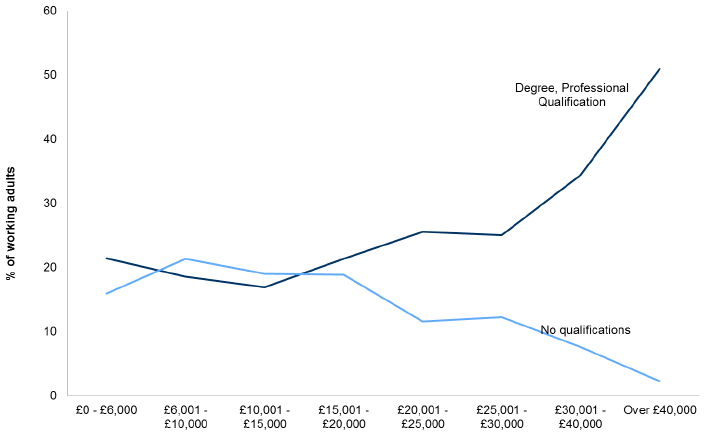
The proportion of adults without any qualifications has decreased from 23 per cent in 2007 to 16 per cent in 2017 while the proportion of adults with a degree or professional qualification has increased from 23 per cent in 2007 to 31 per cent in 2017. The proportion of adults with other types of qualifications has been largely stable (Figure 5.2).
Figure 5.2: Highest level of qualification held by adults aged 16 and over, over time
2017 data, Adults (base: 9,810)
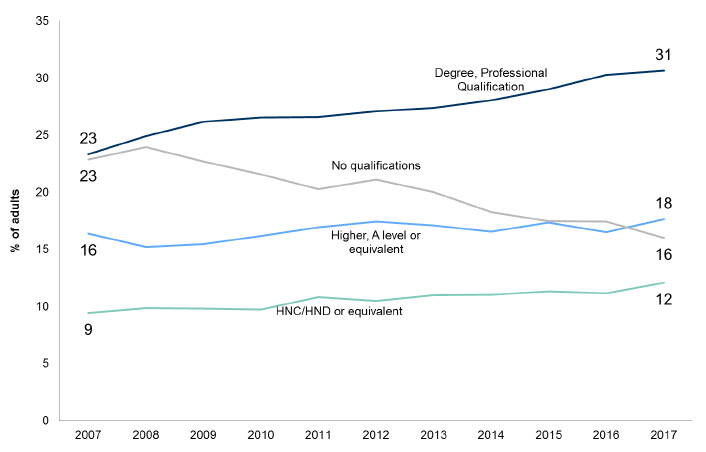
5.3 Current Economic Situation
A higher proportion of men (60 per cent) compared to women (51 per cent) were currently ‘in work’. In 2017, this is demonstrated in Figure 5.3, which shows that men were more likely to be in full-time employment or self-employed, while women were more likely to be employed part-time or looking after the home or family.
Figure 5.3: Current economic situation of adults aged 16 and over by gender
2017 data, Adults (min base: 4,540)
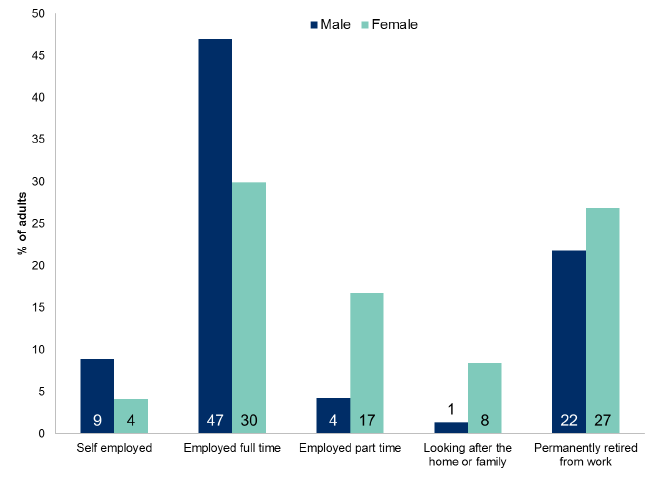
Figure 5.4 shows how the proportion of men and women in work changed over time. More women are now in work than in 1999. The proportion of men in work has been far greater than the proportion of women in work, in 1999 this was 60 and 45 per cent respectively. This gap narrowed to around nine percentage points in 2009 and has been stable since then.
Figure 5.4: Adults aged 16 and over currently in work over time
1999 - 2017 data, Households (minimum base: 4,240)
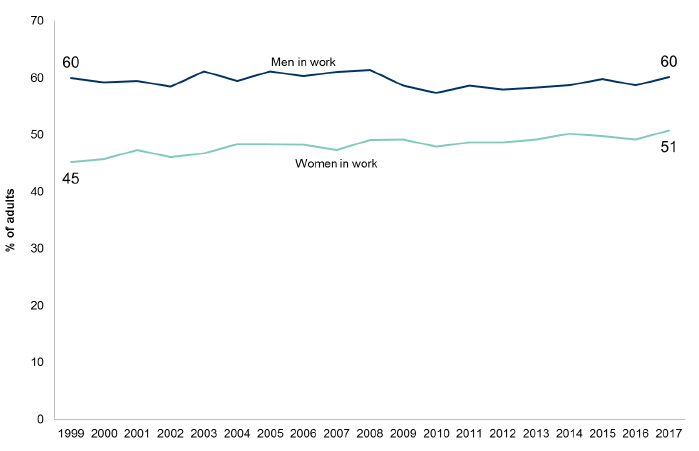
5.3.1 Current Economic Situation of Adults aged 16-64
Figure 5.5 shows the current economic situation of adults aged 16-64 over time. Almost every other adult aged between 16 and 64 years old was employed full time (49 per cent), an increase from 45 per cent since 1999. For the duration of the survey, since 1999, the proportion of 16-64 year olds employed part time has been stable, at around 13 per cent in 2017. The data also shows that the number of those looking after the home or family decreased from nine to six per cent while the number of self-employed increased from six to eight per cent.
Figure 5.5: Current economic situation of adults aged 16 - 64 over time
1999 - 2017 data, Households (minimum base: 6,590)
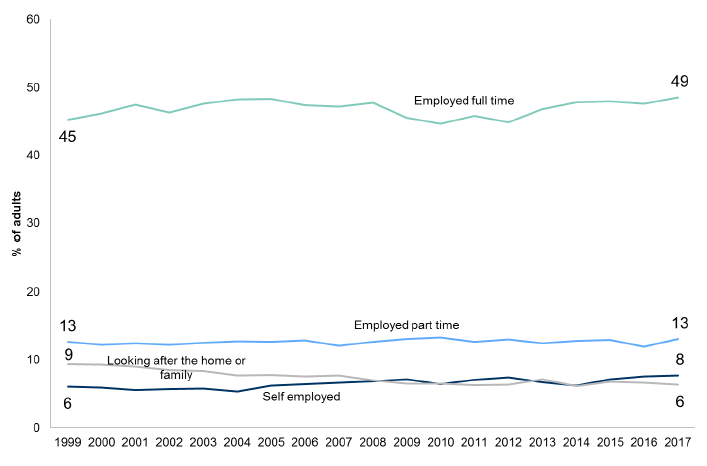
Figure 5.6 shows that men aged 16-64 were more likely to be in employment than women. Men were employed predominantly either full-time (58 per cent) or self-employed (10 per cent). Taken together with the relatively small proportion of 16-64 year old men employed part-time, over seven in ten (73 per cent) men were engaged in some form of paid work.
In comparison, 65 per cent of women aged 16-64 were in some form of paid work. However, there was a greater variation in how women were employed. Full-time employment was the most common type of employment and accounted for 39 per cent of women aged 16-64. Unlike men, the next most common option among women was part-time employment which accounted for 21 per cent of 16-64 year old women.
It was relatively uncommon for men or women aged 16-64 to be permanently retired from work (four per cent males; six per cent females). This is likely to have under-represented all those who have taken early retirement as some who do so will subsequently take up other employment opportunities.
Figure 5.6: Current economic situation of adults aged 16-64 by gender
2017 data, Households (minimum base: 3,140)
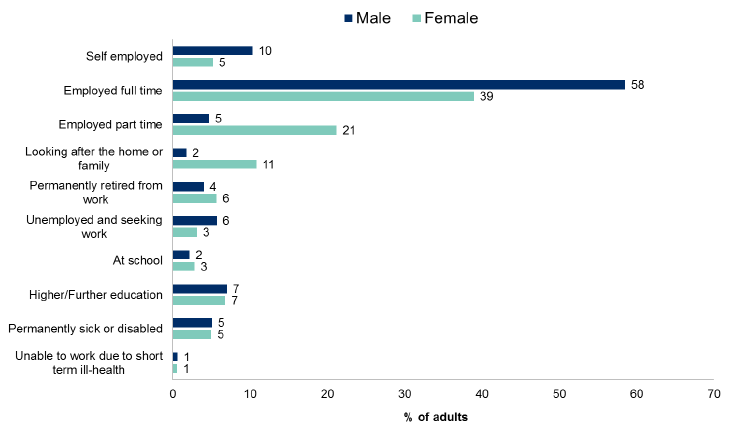
There was a relationship between the highest level of qualification and full time employment (Table 5.3); those who had attained degree level or professional qualifications were most likely to be in full-time employment (59 per cent). In contrast, only around one in three (32 per cent) adults with no qualifications were in full time employment. This group also had the highest proportion (21 per cent) of those who were permanently sick or disabled.
Table 5.3: Current economic situation of adults aged 16-64 by highest level of qualification
Column percentages, 2017 data
| Adults aged 16-64 | Degree, Professional Qualification | HNC/HND or equivalent | Higher, A level or equivalent | O Grade, Standard Grade or equivalent | Other qualification | No qualifications | Qualifications not known | All |
|---|---|---|---|---|---|---|---|---|
| Employed full time | 10 | 10 | 7 | 6 | 4 | 4 | 4 | 8 |
| Employed part time | 59 | 54 | 44 | 43 | 27 | 32 | 34 | 49 |
| Self employed | 12 | 13 | 13 | 16 | 19 | 12 | 12 | 13 |
| Higher/Further education | 4 | 5 | 5 | 8 | 20 | 11 | 7 | 6 |
| Looking after the home or family | 6 | 3 | 4 | 4 | 9 | 7 | 5 | 5 |
| Permanently retired from work | 2 | 4 | 3 | 7 | 4 | 8 | 10 | 4 |
| Permanently sick or disabled | 0 | - | 5 | 6 | - | 3 | 10 | 2 |
| Unemployed and seeking work | 6 | 7 | 16 | 3 | - | 1 | 7 | 7 |
| At school | 0 | 0 | - | 0 | - | 0 | - | 0 |
| Unable to work due to short term ill-health | 1 | 3 | 3 | 6 | 15 | 21 | 10 | 5 |
| Other | 0 | 0 | 0 | 1 | 2 | 1 | 2 | 1 |
| Government work/training scheme | 0 | - | - | 0 | - | - | - | 0 |
| Total | 100 | 100 | 100 | 100 | 100 | 100 | 100 | 100 |
| Base | 2,210 | 910 | 1,200 | 1,370 | 100 | 770 | 60 | 6,610 |
Those with limiting long-term health issues were less likely to be in full-time employment than those with no long-term health issues (Table 5.4). In 2017, over a quarter (28 per cent) of 16-64 year old adults with a limiting long-term physical or mental health condition or illness were permanently sick or disabled and just over two in five (22 per cent) were in full-time employment.
In comparison, over a half (54 per cent) of adults aged 16-64 who reported not having a long-term physical or mental health condition or illness were in full-time employment. When excluding those who are permanently sick or disabled, the proportion of people with limiting health issues who were in full-time employment rises to 31 per cent.
Table 5.4: Current economic situation of adults aged 16-64 by whether they have a long-term physical or mental health condition or illness
Column percentages, 2017 data
| Adults aged 16-64 | All adults aged 16-64 | Excluding 'Permanently sick or disabled' | All | |||||
|---|---|---|---|---|---|---|---|---|
| Limiting long- term condition | Non-limiting long-term condition | No long-term condition | All | Limiting long- term condition | Non-limiting long-term condition | No long-term condition | ||
| Self employed | 5 | 6 | 8 | 8 | 7 | 6 | 8 | 8 |
| Employed full time | 22 | 54 | 54 | 49 | 31 | 55 | 54 | 51 |
| Employed part time | 10 | 13 | 14 | 13 | 14 | 14 | 14 | 14 |
| Looking after the home or family | 9 | 6 | 6 | 6 | 13 | 7 | 6 | 7 |
| Permanently retired from work | 9 | 7 | 4 | 5 | 13 | 7 | 4 | 5 |
| Unemployed and seeking work | 8 | 4 | 4 | 4 | 11 | 4 | 4 | 5 |
| At school | 1 | 3 | 3 | 2 | 2 | 3 | 3 | 3 |
| Higher/Further education | 4 | 4 | 8 | 7 | 5 | 4 | 8 | 7 |
| Government work/training scheme | 0 | - | 0 | 0 | 1 | - | 0 | 0 |
| Permanently sick or disabled | 28 | 3 | 0 | 5 | - | - | - | - |
| Unable to work due to short term ill-health | 2 | 1 | 0 | 1 | 3 | 1 | 0 | 1 |
| Other | 0 | 0 | 0 | 0 | 0 | 0 | 0 | 0 |
| All | 100 | 100 | 100 | 100 | 100 | 100 | 100 | 100 |
| Base | 1,310 | 360 | 4,920 | 6,590 | 890 | 350 | 4,910 | 6,140 |
5.4 Working Households
In this section the number of adults (aged 16 years and over) in paid employment in households is examined. This is followed by an analysis of the current economic situation of women; specifically investigating whether the presence of children in the household might have an impact on their economic situation.
5.4.1 Adults in Paid Employment
As Figure 5.7 shows, in 2017 for Scotland as a whole, just over three fifths (62 per cent) of households had at least one adult in paid employment; over a third of households (34 per cent) contained two or more adults in paid employment and 28 per cent had one adult in paid employment. The remaining households (38 per cent) contained no adults in paid employment.
The number of working adults in a household varied according to the deprivation levels of the area in which they were situated. Just over a half of households in the 20 per cent most deprived areas contained at least one adult in paid employment (54 per cent). In comparison, almost seven in ten households in the 20 per cent least deprived areas contained at least one adult in paid employment (68 per cent).
It is important to note that while these estimates demonstrate that households in the most deprived areas were less likely to contain adults in employment, these households also contained fewer adults and we would therefore expect to see a smaller proportion of households in these areas having two or more working adults. Furthermore, the figures presented here are for all households that took part in the survey. This means the data presented includes people who you would not necessarily expect to be in paid employment. For example, pensioners, people who have taken early retirement and students are all included. The results have not been broken down further because the SHS is not the recognised source for employment statistics.
Figure 5.7: Number of adults aged 16 and over in paid employment by Scottish Index of Multiple Deprivation
2017 data, Households (minimum base: 1,980)
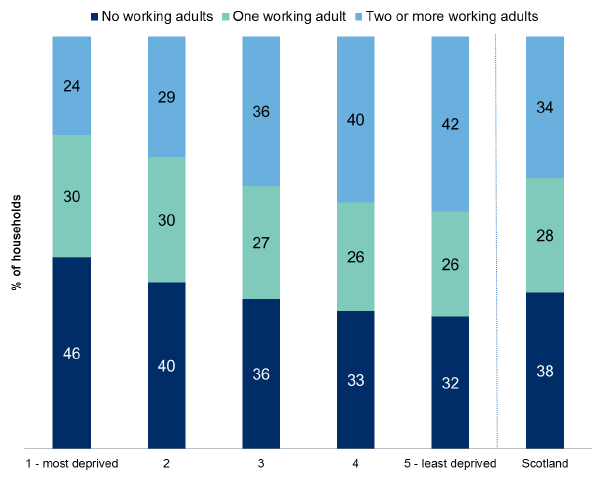
5.4.2 Women aged 16-64
The final section of this chapter focuses on the current economic situation of women aged 16-64 and examines the difference in situation according to whether there are children in the household.
Figure 5.6 showed that the majority of 16-64 year old women are in some form of work and Figure 5.8 shows that the presence of children in the household does not affect this considerably; in 2017, 66 per cent of women in households containing children were in work, compared to 65 per cent of those without children.
The main differences between the two groups of women aged 16-64 were that a higher proportion of those with no children in the household were employed full-time (45 per cent compared with 29 per cent of those where children are present), while a higher proportion with children in the household were looking after the home or family (22 per cent compared with 4 per cent of those with no children present) or employed part-time
(32 per cent compared with 15 per cent of those with no children present).
Figure 5.8: Current economic situation of women aged 16 and over by presence of children in the household
Column percentages, 2017 data
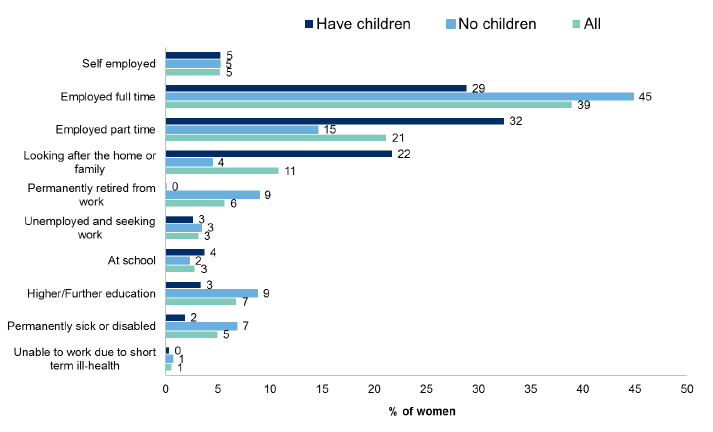
Contact
There is a problem
Thanks for your feedback